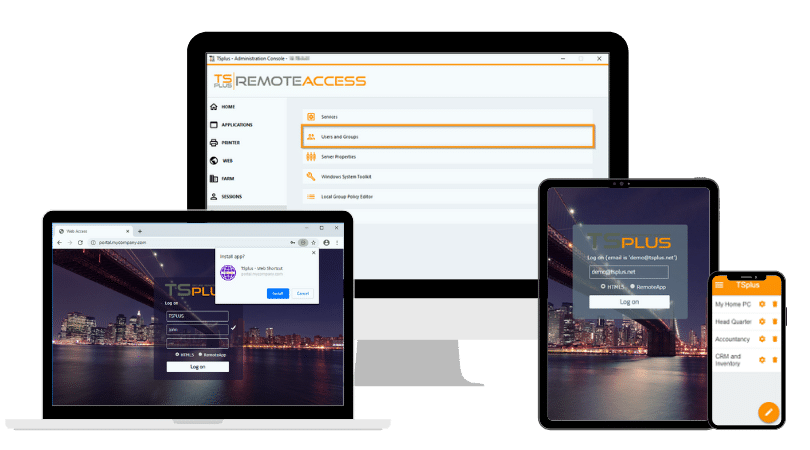)
)

TSplus Remote Access Free Trial
Ultimate Citrix/RDS alternative for desktop/app access. Secure, cost-effective, on-premises/cloud
Core Components of Application Virtualization
Understanding Hypervisors
Type 1 and Type 2 Hypervisors
Type 1 hypervisors, or "bare-metal" hypervisors, run directly on the host's hardware, offering robust performance and security due to their direct access to hardware resources. They are ideal for environments where performance and security are critical, such as data centres. Type 2 hypervisors, however, run on top of an existing operating system, which makes them easier to set up and manage but potentially introduces additional overhead, affecting performance. Type 2 is often used for testing environments or smaller scale deployments where full isolation isn't as critical.
Hypervisor Responsibilities
Hypervisors play a crucial role in the management of virtual environments. They not only manage the creation, execution, and resource allocation of virtual machines but also handle the execution of multiple operating systems on a single physical workstation or server. This ability to manage multiple instances efficiently is what allows for significant improvements in resource utilisation, flexibility, and scalability within IT environments.
Application Streaming and Isolation
Streaming Technology
Application streaming is an advanced delivery method where only the necessary parts of an application's code are sent to the client's device, where it's executed on-demand. This model is highly efficient because it allows for rapid deployment and updates, and reduces the local device's storage requirements, as the entire application doesn't need to be installed—just the needed components.
Sandboxing
Sandboxing is a security technique in which a separate, secure environment is created to run untested or untrusted programs or code. This ensures that any potential issues do not affect the underlying host system. For applications, this means that any operation by the application occurs within this sandbox, greatly limiting the risk and impact of security vulnerabilities.
These advanced hypervisor capabilities and virtual application delivery methods demonstrate the technical depth and strategic flexibility that application virtualization offers modern IT environments, allowing for enhanced operational efficiency and improved security measures.
Implementing Application Virtualization
Planning and Assessment
Evaluating Applications for Virtualisation
Choosing the right applications for virtualization involves a thorough assessment of each application's architecture, compliance requirements, and how they interact with other applications and systems. Considerations should also include the potential benefits of virtualization against the cost and complexity of implementing it. For instance, applications with high I/O demands might not perform well when virtualized unless sufficient network resources are available.
Deployment Strategies
Centralized vs. Decentralized Deployment
Centralized deployment is typically easier to manage and update but can strain network resources and central servers. This model suits applications that do not require intense real-time processing or rapid local responsiveness. In contrast, decentralized deployment can reduce latency critical for applications requiring high-speed processing close to the user base, though it complicates management and security protocols.
Security Considerations
Protecting Virtual Environments
A key aspect of security In virtualized environments, the encryption of data transmissions is essential to protect data integrity and confidentiality during transit. Administrators must also implement robust authentication processes to ensure that only authorized users can access the virtualized applications. Furthermore, maintaining the security of the underlying virtualization infrastructure is crucial to prevent vulnerabilities that could affect all hosted applications.
Enhanced security measures, thorough planning, and strategic deployment are foundational to successful application virtualization. These elements ensure that virtualization delivers on its promise of efficiency and flexibility while minimizing potential drawbacks and risks.
Challenges and Best Practices
Performance Optimization
Resource Allocation
Effective resource allocation is essential to optimise performance in virtual environments. It involves assessing and distributing computing resources like CPU, RAM, and storage to meet the demands of virtual applications without overcommitting or underutilising hardware. Advanced resource allocation strategies may include automated scaling solutions that dynamically adjust resources based on real-time application demands, ensuring optimal performance at all times.
Network Dependencies
Mitigating Connectivity Issues
Enhanced strategies for mitigating connectivity issues include implementing advanced network routing protocols and traffic management solutions to prioritise critical application data. Additionally, deploying edge computing devices can help by processing data closer to the source of data generation, thus reducing latency and reliance on central data centres. These approaches are particularly important in environments where quick data access and processing are crucial for application performance.
User Experience and Support
Ensuring Seamless User Interaction
Enhancing user experience in virtual applications requires a focus on minimizing latency, ensuring graphical fidelity, and maintaining feature parity with non-virtualised applications. Responsive design should adapt to different devices and operating conditions, providing a consistent and intuitive interface across all platforms. Comprehensive user support includes proactive monitoring tools that alert support teams to potential issues before they affect users, alongside training resources that empower users to make the most of virtual applications.
These best practices and strategic approaches address common challenges in application virtualization, helping to maintain high performance and user satisfaction while optimising resource use and minimising network-related disruptions.
Why Choose TSplus for Application Virtualization?
TSplus Remote Access stands out as a superior solution for application virtualization, offering robust security features, efficient resource management, and exceptional support. Its technology ensures that businesses can leverage the full benefits of application virtualization, making it an invaluable tool for any IT-driven organization. To learn more about how TSplus can enhance your application virtualization strategy, visit TSplus.net.
Conclusion
Application virtualization offers significant advantages for IT infrastructure, including enhanced security, cost efficiency, and streamlined management. Successfully implementing this technology requires careful planning, strategic resource allocation, and robust security measures. Addressing performance optimization, network dependencies, and user experience are key to leveraging the full benefits of virtualization. With these practices in place, organizations can achieve a flexible and scalable IT environment.

TSplus Remote Access Free Trial
Ultimate Citrix/RDS alternative for desktop/app access. Secure, cost-effective, on-premises/cloud














)
)
)